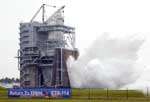Engineers test the first engine for NASA's Return to Flight mission

On July 16, engineers at NASA's Stennis Space Center in Mississippi successfully tested one of the Main Engines that will carry the next Space Shuttle into orbit. The engine will be shipped to NASA's Kennedy Space Center in Florida for installation on Space Shuttle Discovery, the next Shuttle slated for flight. The Return to Flight mission, designated STS-114, will launch no earlier than next March to the International Space Station.
Engineers at NASA's Stennis Space Center (SSC) in Mississippi successfully tested Friday, July 16, one of the engines that will carry the next Space Shuttle into orbit.
The test was the first on a complete Space Shuttle Main Engine (SSME) that will be used on the Return to Flight mission. It will be shipped to NASA's Kennedy Space Center for installation on the Space Shuttle Discovery. The Return to Flight mission, designated STS-114, will launch no earlier than next March and will go to the International Space Station.
The test began at about 3:59 p.m. CDT. It ran for 520 seconds, the length of time it takes a Space Shuttle to reach orbit. Initial indications are all test objectives were successfully met.
"It's good to see hardware processing for Discovery moving forward at Stennis and other NASA centers," said Michael Kostelnik, deputy associate administrator for International Space Station and Space Shuttle Programs. "Clearly, we're making real progress in safely returning the Shuttle to flight and enabling the Vision for Space Exploration."
"This Return to Flight test is a testimony to the hard work of the NASA and contractor team that developed and continues to improve the SSME's capability to take humans to low Earth orbit safely," said Miguel Rodriguez, director of the Propulsion Test Directorate at SSC. "It is a huge source of pride to the NASA and Boeing team to be part of this great program."
Developed in the 1970s, the Space Shuttle Main Engine is the world's most sophisticated reusable rocket engine. A Space Shuttle has three main engines. Each is 14 feet long, weighs about 7,000 pounds and is seven-and-a-half feet in diameter at the end of its nozzle. It generates almost 400,000 pounds of thrust.
Engineers conduct rigorous testing to verify that an engine is ready to fly. The most modern versions of the SSME include a new high-pressure fuel turbopump that was first used in July 2001.
"The Space Shuttle Main Engine that flies today has gone through major upgrades and is safer, stronger and more reliable than the one that flew on the first Shuttle flight in 1981," said Michael Rudolphi, Space Shuttle Propulsion Manager.
The Rocketdyne Propulsion and Power division of The Boeing Co. of Canoga Park, Calif., manufactures the Space Shuttle Main Engines. Pratt and Whitney, a United Technologies Company of West Palm Beach, Fla., builds the high-pressure turbopumps. The Space Shuttle Main Engine Project is managed by the Space Shuttle Propulsion Office at NASA's Marshall Space Flight Center in Huntsville, Ala. SSC conducts engine tests.
For more information about NASA's Return to Flight efforts, visit: www.nasa.gov/returntoflight
Source: NASA
















